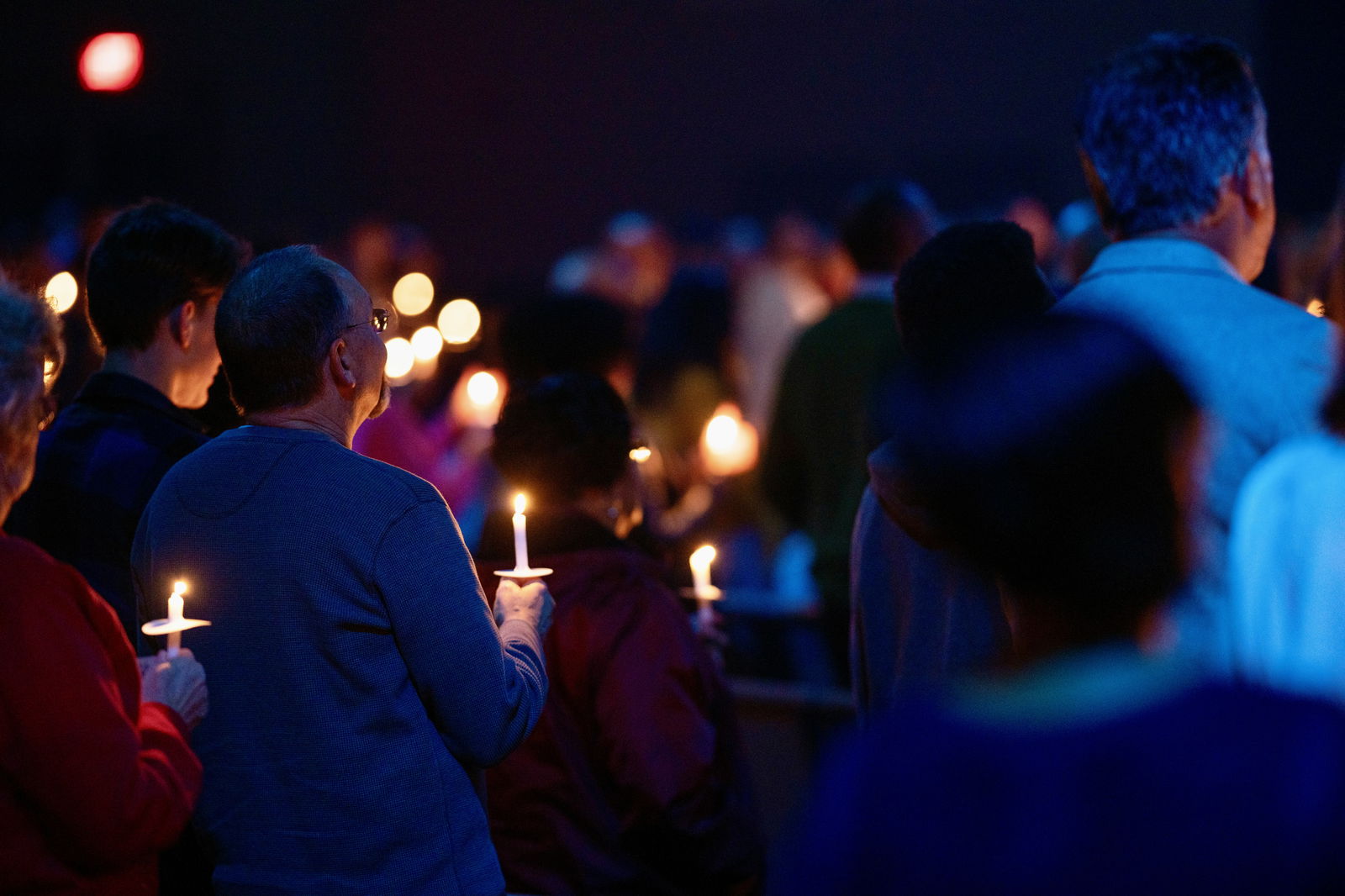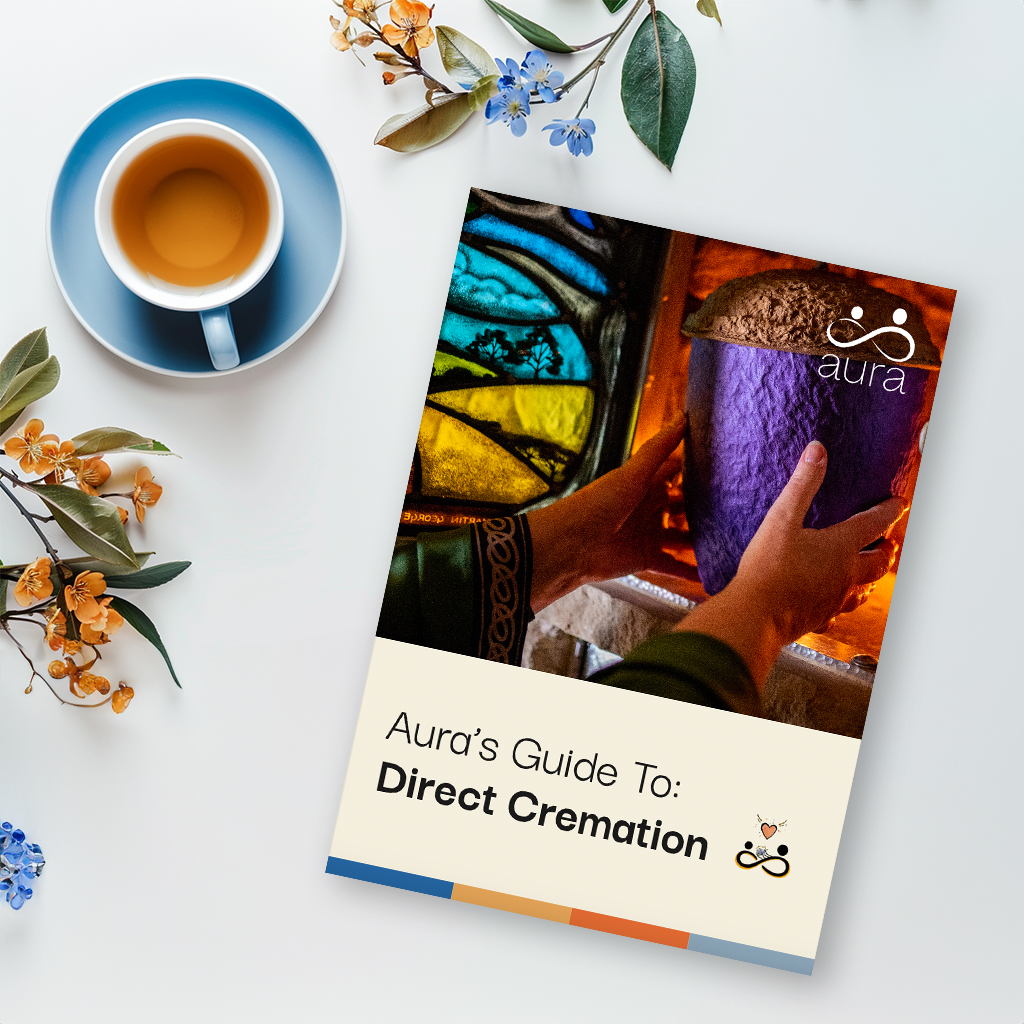


Written by Emily Cross.
15 minute read
When a public figure dies, it’s normal to feel a perhaps surprising sense of loss, even if you never knew them. Through music, sport, or film, celebrities often become a steady part of our lives. That’s why celebrity funerals can feel strangely personal, stirring emotions that run deeper than we expect.
Aura understands that moments like these can stir up a mix of emotions, particularly if you’re mourning someone close or feeling emotionally unsettled.
If this guide has raised thoughts you’d like to explore, we can support you with every part of direct cremation — a flexible and more personal alternative to traditional funerals. You may also find that witnessing a public funeral prompts you to consider the legacy you wish to leave behind. If so, our *prepaid funeral plans are here to offer peace of mind and something solid to hold onto.
*Terms, exclusions and eligibility criteria apply. Please read our Funeral Plan Summary before deciding.
Key takeaways:

Celebrity funerals are known for attracting a high degree of public attention because millions of us feel an attachment or sense of connection with the celebrity who has died. Public figures and celebrities we have followed for many years may have provided a sense of permanence in our lives, resulting in a real sense of loss when they die. Many people choose to pay their respects by watching parts of the funeral on television or, where they can, by gathering along the procession route.
It is not uncommon for celebrity funerals to become times of collective mourning where large swathes of society come together to share thoughts, feelings, and an overarching sentiment.
The funeral of Princess Diana is perhaps the most notable in living memory for many of us, while previous generations may have felt the same about the state funeral of Winston Churchill. They both become collective moments in the nation’s history in which millions of people from many different walks of life found themselves thinking and reflecting on a common set of feelings and emotions.
The rapid expansion of 24/7 media coverage and social media has given the British public more access than at any point in the nation’s history. Being able to share online tributes, view many major events in real time, and exchange memories, thoughts, and ideas with people across the country with the click of a button has intensified the public mourning and grieving process in many ways.
Throughout history, many well-known figures from the UK and beyond have been honoured with funerals that left a lasting impression. Princess Diana, the late Queen Elizabeth II, Michael Jackson, Whitney Houston, and even as far back as William Gladstone and Isaac Newton are examples of significant public funerals.
Although each of their funerals had a wide array of personal and traditional elements, there was typically a key distinction one way or the other, especially for those funerals held in the UK.
A state funeral is paid for by the Crown and is typically highly formal, traditional, and often military in nature. They are reserved for serving monarchs and then extended to those who are deemed to have made exceptional contributions to public life. State funerals will have the following key elements:
State funerals are public occasions, created to give people the chance to say goodbye to someone who’s played a major role in public life. These moments of national mourning often strengthen how that person is remembered.
Both Queen Elizabeth II and Winston Churchill were granted state funerals in the heart of London, with footage beamed around the world. In fact, an estimated 4.1 billion people viewed the late Queen’s funeral, making it, reportedly, the most-watched event in history.
Some celebrities opt for private, or intimate funerals that are designed to meet the needs of close family and friends. David Bowie’s funeral is a good example of this as it combined a minimalist service with a direct cremation immediately after. His ashes were then scattered in Bali, a place he saw as his spiritual home, while a series of Buddhist rites were read.
Bowie’s wish was for him to be remembered in life and through his music, rather than be mourned in death. Given the cultural impact he had, his wish for a private funeral likely avoided a mass public outpouring of grief at a public funeral. Though millions of people felt a sense of loss when David Bowie died, what stood out was how his fans respected his wishes, choosing to honour him in a quiet, dignified way.
Other famous figures choose to have a private funeral service reserved for friends and family followed by a public memorial service at a second location. By taking one of the alternative funeral ideas open to them, the family can strike what they see as the right balance between processing their own loss and letting members of the public make their own tributes.
There are so many funeral options & alternatives that it can be hard for anyone planning a funeral to decide the specific path to take right away. This may be compounded in the case of those organising a funeral for a high-profile person beloved by millions around the world. You might consider some of the different approaches that have been taken over the years, as well as why these approaches were chosen.
A notable number of celebrity funerals are extraordinarily grand, and designed to have elements of performance that reflect the desires of the celebrity who has died. Public figures, particularly former monarchs, will also have more complex funerals, but they will typically be more steeped in tradition than subject to personalisation.
Here are some famous examples:
The funerals of such high-profile individuals can quickly become iconic cultural moments in their own right. It is normal for many people to remember where they were when they learned that a member of public life had died and to even feel a deeper sense of connection with them than they did when they were still alive.
Fans and followers may also feel a greater sense of appreciation for an artist, writer, or performer when they have died because they will know that they will never again experience brand-new work from them and the joy that this may bring them. Knowing that the person they followed is being bid farewell with a funeral service that aligns with their larger-than-life personality may serve as a sign that their wishes are being followed, and they are shaping culture even after they have died.
Other famous figures have made unexpected funeral requests that typified their approach to both life and death. Perhaps the most striking is the writer Hunter S. Thompson’s request for his ashes to be fired from a cannon into the air. To readers of his work, this epitomised his propensity for pushing the limits when he was alive, which many see as the reason he was able to write with such power regarding the human condition.
Lynda Bellingham’s love of music and entertainment resulted in her funeral being not just a celebration of her life, but the closest thing to a live music performance and dance many attending had experienced. It created a sense of connection with her many fans, allowing them to feel included in a moment that felt true to what she would have wanted.
Malcolm McLaren’s funeral was punctuated by a hearse that was followed by a large group of singers who sang Sid Vicious’s version of “My Way” and served as a strong tribute to the influence punk rock had on his work.
Wild animal expert Steve Irwin, who tragically lost his life while handling a deadly stingray, had his funeral at the 60-acre zoo his family owns. The choice of venue reflected his lifelong passion and the fact that his legacy could continue irrespective of how his untimely death had occurred.
If you are processing the death of someone in your personal life and want to find a way to personalise the way you say goodbye to them, you may find it helpful to look at these traditional cremation alternatives. Please do not feel any pressure to read them now, we share them simply so that you know they are there when you feel ready.
Live broadcasts and social media have changed the way we experience public mourning, especially when comparing today’s state and public funerals to those of the past. While the sense of loss the nation experienced when Churchill died in 1965 may well have been equal to those when Queen Elizabeth II died in 2022, the media was completely different.
2022 presented members of the public with instant and continuous access to the very latest footage, images, and opinions of other notable people around the world. Social media also gave people the chance to share personal tributes instantly, making it easier than ever to express their feelings and memories.
Digital media has played a significant role in how deaths are reported and discussed. In some cases, it has led to concerns around intrusion and privacy. Following Whitney Houston’s death, there was widespread speculation about the cause, and later, images of her in her coffin were leaked to the press.
Everyone has the right to work through some semblance of the five stages of grief at their own pace and in a personal way; however, there are boundaries around privacy and respect that are widely recognised. A public person is seen as something of a commodity once they reach a certain level of fame, but it can be helpful and healthy to remember that they are still people with loved ones and friends who are grieving their deaths.
High-profile celebrity funerals influence public remembrance and the memorials that may follow by setting the tone for a collective act of mourning. Perhaps the most powerful example of this is the funeral of Princess Diana. The traditional nature of her funeral and the solemn image of her sons walking behind her coffin set the tone for a period of deep mourning and an intense outpouring of emotions for millions of people who may have never met her personally.
Public funerals can also lead to permanent tributes in the form of statues, museums, or dedicated foundations for the most notable or wealthy members of public life. These tributes are contributions to society that are designed to help remember and define the legacy of the person who has died as well as to provide a point of focus for their fans and followers who feel they need a place to pay their respects.
You may also find that these events help to shape conversations about grief and loss within your own family or friendship group. Being able to sit and reflect on what it means to die and how it can change or influence how your life is thought about may prove to be a healthy and forward-looking exercise for some.
The process of managing your emotions and coming to terms with the fact that someone who was a part of your life has died can be understandably difficult and emotionally challenging at times. It is also something that may allow you to learn about yourself and how you think about others during difficult times.
We believe that the role of a family-run funeral provider such as ourselves is to provide guidance, support, and comfort as opposed to focusing purely on planning and making arrangements. In our experience, a listening ear and a kind word can go a long way, and the same is true if you are thinking about how to process your emotions when a public figure you cherish dies.
As part of the act of public mourning, you might begin to reflect on the choices you will have to make if someone you love dies. Should the need arise, we have a guide that will help you to compare funeral plans, a detailed explanation of our cremation services, and up-to-date information regarding practical matters such as direct cremation prices. We share these links only so that you know help is available as and when you may need it.

If you’d like more information about direct cremation and Aura’s funeral plans, then our downloadable guide can help. Find out why others are choosing this affordable, no-fuss alternative to traditional funerals and why it might be right for you too.
Download our guide by clicking the link below and learn more about this simple funeral plan option.
Princess Diana’s funeral is estimated to have been watched by 2.5 billion people around the world, and that of the late Queen Elizabeth II was watched by as many as 4.1 billion viewers. One of the reasons for this is thought to be the sense of permanence that key figures in national institutions such as the Royal Family provide to everyday people. A period of public mourning and collective loss was experienced in both cases and many people found that speaking openly about how they felt at public memorials, or by leaving written or symbolic tributes, helped them to process their emotions and sense of loss.
A state funeral comprises a military procession, a period of lying in state, and a service that is conducted at Westminster Abbey or St Paul’s Cathedral. Famous figures outside of the line of the monarchy who have received state funerals include Winston Churchill, William Gladstone, Lord Palmerston, Isaac Newton, Lord Nelson, and the Duke of Wellington.
While the public outpouring at the death of Princess Diana is perhaps unrivalled in living memory, a great number of people publicly grieved the deaths of cultural icons Cilla Black and Lynsey de Paul. Lynsey de Paul’s funeral, in particular, was a highly emotional event due to the profound shock that many close to her expressed about her untimely death.
This is a matter for the next of kin, even in the case where the global public profile of a notable person makes everyone feel like they have some form of relationship with them. The case of David Bowie mentioned earlier highlights how global stars and cultural icons still reserve the right for a modest, private final act if they so wish. Others, particularly in the case of those receiving state funerals, will have expressed a wish for highly public occasions that allow millions of others to pay their own tributes.
Although the emotions of many fans and followers may run high at such times, the most important thing to remember is that public figures still have family and close friends. Respecting their wishes will ensure that the right boundaries are kept while they are processing their own grief.
Many celebrities and public figures choose to plan their funerals while they are still alive so that they can create a final act that they feel is befitting of their legacy. In the case of the Prime Minister or a monarch, there are dedicated teams of people whose job it is to have funeral plans in place in what may prove to be decades before they die.
Some celebrities and public figures may also feel that by having a plan in place in advance, they can remove some of the emotional pressure placed on the people they leave behind. A pre-planned public funeral can remove many of the potential disagreements and result in a fitting tribute that matches their achievements, personality, and public perception.
staging site last replicated: MISSINGNO.